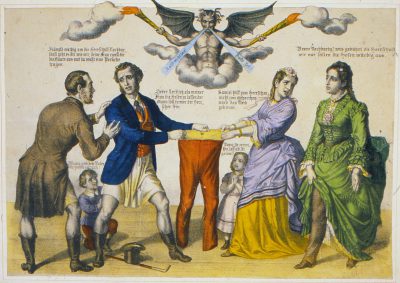Topics of the book (12 chapters)
01 Men's Trousers - Women's Skirts
As is well known, trousers were not only a part of clothing, in our cultural sphere they were a part that pointed beyond itself from the late Middle Ages until our century. Trousers marked the male sex, were considered pars pro toto.Their possession symbolised masculinity, male potency and superiority, their absence the loss of the same. However, this identification pattern is not compelling, but is solely based in its traditional attribution. Continue reading >
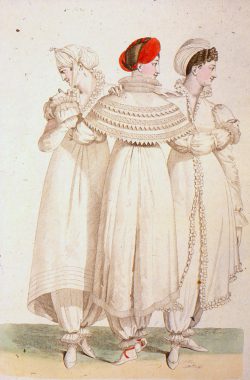
02 Female Dress Experiments at the Time of the French Revolution
"On the Male Fashion Tone of French Ladies" - New Amazons - The Pantalons of the Merveilleuses
During the course of the 18th century, previously valid, class-determined gender roles began to change. With the rise of the bourgeoisie, a separation between the male and female world - the factual professional world of the man and the idealised domesticity of the woman - became increasingly apparent. For a few, however, the ideas of the Age of Enlightenment were also the impetus for a first critical reflection on the role of women in bourgeois society. Continue reading >
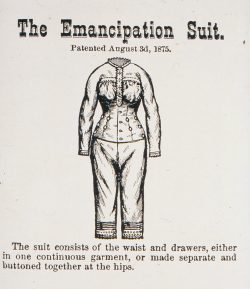
03 Medical Profession pro Caleçons .
„Everything which alters or disguises Nature proceeds from a false taste […]. Everything that constrains Nature, or hinders the freedom of action, proceeds from a depraved taste.“ Gentleman’s Magazine (1738)
Few contemporaries were as outspoken about the unnatural constraints of fashion as this unnamed author of an English gentleman's magazine in the early 18th century. In fact, the prevailing dress, dictated by contemporary fashion, was the stark opposite of a costume in harmony with human nature; it coerced, raped and hindered the body in many ways. Continue reading >

04 The "Battle Dress" of North American Women's Rights Activists from 1851
Trouser-Wearing Women in the First Half of the 19th Century - Amelia Bloomer's Trouser Costume - Women's Right to Trousers Bloomerism Nationally/ Internationally - Anti-Bloomerites and Bloomer Girls - The Phenomenon of Bloomerism
Long before the propagation of short dresses and long trousers by American feminists provoked heated public debate, there were already women's groups that did not follow the dictates of women's fashion. For example, the adaptation of trousers by women in religious-social communities in North America, precursors of the so-called "Bloomer costume", can be interpreted as a questioning of the female dress tradition of Western cultures. Continue reading >

05 Trouser Costumes, the Rational Alternative for Courageous Ladies
IInternational Dress Reform Efforts - German Initiatives to Improve Women's Dress - "Rational Dresses": Propagated, Defamed, Accepted
In the second half of the 19th century and the first two decades of the 20th century, voices were raised, first in the United States, but soon also in Europe, calling for a correction of women's clothing that was harmful to health and inhibited movement. Advocates of dress reform began to form associations with the aim of publicising their efforts. Continue reading >

06 Development of Women's Sports and Women's Sports Trousers
What is Appropriate for the "Fair Sex"? - Amazonian Costume: Ladies on Horseback ̶ From the Gymnastic Dress to the Leotard - Trouser Suits as Activity Wear: Conquerors of the Mountains, Diana's Clothing, Hiking Costumes, Ice Costumes, Winter Sports Suits for Ladies - Cyclists Dressed in Trousers
The bourgeois woman of the first half of the 19th century, excluded from working and professional life, spent her everyday life sitting in a domestic atmosphere, waiting, embroidering, reading, writing, making music, representing - and not infrequently bedridden, nursing her illnesses. Virtuousness and physical inactivity seemed to be indissolubly interwoven. Continue reading >

07 The "Sportification" of Women
“We want to move freely”: Bathing and Swimming Costumes, Fencing Suits, Lawn Tennis Dress, Sportswear for Team Sports - Clothing for Aeronautics - From Grace to Power
Around 1900, women who practised sport, a barely noticeable minority around 1870, had grown into a publicly visible group that began to test itself in all areas and to compete with male performance. Activities that had previously been simply unthinkable for the female sex were initially socially tolerated as so-called "ladies' sports", i. e. a variant in which grace and beauty were in the foreground and any effort was to be avoided, until finally female competitive sport became established, in which the competitors dominated. Parallel to this, women's sportswear developed, whereby astonishing divergences can be observed in the various sports disciplines. Continue reading >

08 Female Workwear Trousers
"... out into hostile life ..." - Female Working Clothes Before 1914 - 1914/18: Women's Service for the Homeland - "War work clothes" in Rational Dress Movement Bulletins and Fashion Magazines 1914/18 - Men's Work in Men's Trousers
The study of the history of trousers as part of women's professional and work clothing shows how the activities to be performed affected female dress behaviour. Which activities could women carry out in skirts, when were trousers in vogue? And how did the process of establishing work trousers for women proceed? Continue reading >
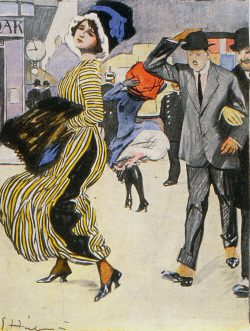
09 Women's Trousers: A Public Nuisance Becomes Fashionable
Fashion Ladies of the Pre-War Era - The "New Woman" Shows Leg - Fashion Experiment and its Uptake
By the end of the first decade of the 20th century, the line of women's fashion had shrunk to such a tightness that its culmination point in this direction had been reached. Floor-length skirts that narrowed below the knee and fitted the shape of the body like a second skin not only traced the contours of the legs in all clarity, but also made it impossible for fashion-conscious ladies to stride out naturally. Tripping about, tucking in their skirts and unable to board railway carriages, carriages or automobiles without assistance, fashion models countered the trend of the time towards more independence and mobility. Continue reading> >
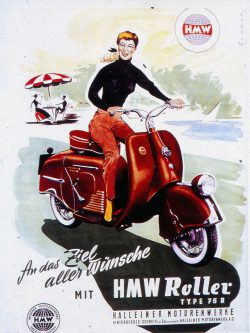
10 Women's Trouser Practice after 1930
"Everything in its time": Women's Trousers 1930-1949 - Trouser-Wearing Women of the Economic Miracle Years - Skirt Equal to Trousers? - Excursus: No Admission in Trousers
Trousers retained their firm place in the female clothing spectrum in the 1930s, although after 1930 fashion took its leave of the ideal of the girl and once again took the mature woman as its model. In a departure from the experiments of the 1920s, the new fashion line focused on buoyant femininity, skirts became longer and wider, cuts more body-hugging. Girls verabschiedete und wieder die reife Frau zum Vorbild nahm. In Abgrenzung zu den Experimenten der 1920er Jahre setzte die neue Modelinie auf beschwingte Fraulichkeit, die Röcke wurden länger und weiter, die Schnitte körperbetonter. Continue reading >
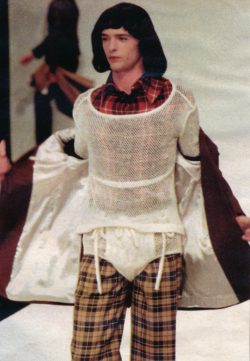
11 Asexual Legwear in the 21st Century
The gender assignment of trousers, which stood for men in Western European and North American countries since the Late Middle Ages, has definitely been passé since the 1970s. The image of woman = skirt and man = trousers has largely dissolved, pictograms worldwide adapted to this process. The categorisation into either male or female has also been officially recognised as insufficient in the meantime and opened up to a broad spectrum of identities by adding 'diverse'. Continue reading >
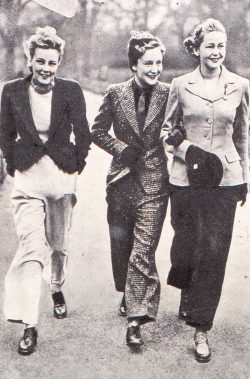
12 History of Women’s Trousers as History of Women's Emancipation
This attempt to reconstruct the history of women's trousers from the first preludes to fashion around 1800 to their establishment as functional and leisure wear, then as a common part of women's day and evening dress, shows that the process of establishing women's trousers did not primarily take place in the fashion sector, but in everyday life. Continue reading >
Text: © Gundula Wolter | Images: © the copyright holders (see photo credits)
Any use of the texts and images outside the limits of copyright law is not permitted and is punishable by law. This applies in particular to translations, reproductions, microfilming and storage and processing in electronic systems.
